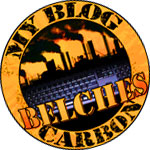
Once upon a time, crusty old Uncle Bill was a real Boy Scout (Well, until that unfortunate incident with Arkela, those two Girl Guides and that game of 'strip spin the bottle'). He learned many tidbits of practical wisdom about living outdoors, and why it is strictly for those who enjoy such edifying pursuits as self flagellation with barbed wire whips and sticking one's willy into an active Wasp nest.
Nevertheless, before being ceremonially stripped of his Woggle, he had learned the basics of how to read a map and navigate cross country using a compass. He also learned about wildlife, and how not to get bitten by some (but sadly not all) of it. He also learned the fine art of building and lighting a nice toasty log fire. An essential Winter time skill.
Log fires? Well it's easy innit? Any bloody fool can light a fire. All you need is wood and gasoline, oh and a match. Pile up wood, pour on gasoline and strike match. Well the aforementioned is a quick and easy method for quickly igniting fires, especially if you don't care much for your eyebrows or interior decor. Firelighters also work, but they are so infernally slow. The object of this exercise it to quickly light a fulsome and warming glow that gives out a lot of heat and doesn't generate much asthmatic wheezing because it's smoking the place out. A key objective is minimal smoke creation. A fire that burns quickly and forms a nice bed of orangey red hot embers is best. A smouldering heap simply stinks the place out and may result in the Fire Brigade / local council / environmental activists paying you an unwelcome visit. It's crap at warming you up as well.
For myself, I prefer a more studied method that obviates the singeing of facial hair and other teensy inconveniences. All it takes is half an hour and a little attention to detail.
Before 'laying' fireplace; cut logs. Preferably from old, dry wood. Best burning woods are Birch, young Oak, Horse Chestnut etc. Fruit trees are also very good. Acacia and Rhododendron not so much. Pine is often too resinous and will spit and crackle alarmingly all over the place, leaving little black scorch marks in your nice fireside rug and immolating your household pet. Said logs should be no longer than the width of your fireplace or stove grate. Logs a little more than the diameter of the palm of your hand are also best. For the purpose of this exercise, we will assume you know what the bloody hell a dry log looks like. If not, turn up the central heating instead, for heating of this nature is destined not to be your forte.
For those dogged souls determined to press on regardless, the next few steps should be followed religiously (Literally, fire laying is best done kneeling).
Step 1; In a grate or stove when you are reasonably confident the vents and chimney are clear and swept (Not choked up with soot, or inconveniently blocked with wodges of old newspaper), crumple up a few handfuls of dry newspaper to cover the entire bottom of the grate. Magazine flyers, old envelopes and junk mail are good too, glossy magazines not so, because the china clay that is used to make the pages glossy isn't much good for firelighting. However, in a pinch it will suffice.
Step 2; On top of the paper, lay the thinnest kindling on the first layer in a grid pattern. FYI Kindling wood is thin cut, and above all dry wood roughly cut into approximate 30cm lengths about 10mm square or maybe a little more. Some can be thinner, some thicker. If you're the patient type with a sturdy and sharp pocket knife, you can even make some wood shavings and cast a loose double handful onto the kindling grid.
Step 3; put another grid of kindling wood on top crosswise to the first, and repeat twice. This is the grid method of building a fire, and as far as I'm concerned, the best for getting a good blaze quickly.
Step 4; using the smallest dry logs you have, put a single layer on top.
Step 5; strike match and light paper. If using a stove, close the door, but do not drop the catch.
Step 6; wait. Fire should begin to burn fairly rapidly. If it doesn't, and appears to go out, quickly blow on the embers three times. If it hasn't relit by now you tried to light the fire with damp or unsuitable materials. Smacked wrists. Try again.
Step 7; assuming you've lit the fire successfully, wait until first layer of logs is well alight before adding some larger ones.
Step 8; stand in the 'at ease' position proprietorially in front of the blaze to warm your buns and the backs of your legs, refusing to let the family pet / child / wife / husband / significant other close until you are sufficiently toasty to step aside. Sod it. It's your bloody fire, you laid it and lit it, they can wait their turn.
Stack any damp logs at least half a metre to one side of your blaze to dry overnight, no closer. In the meantime, put a log on the fire when the bed of red hot embers starts to die down, the one exception being if you're going to bed, in which case, don't put any new logs on the fire for at least two hours beforehand.
Cautionary note; FFS don't overload the fireplace, or you run the risk of a chimney fire, which aren't much fun, and will result in a visit from the fire brigade, or possibly worse; 'elf 'n safety.
If, on the other hand, you have successfully negotiated the pratfalls and pitfalls of the aforementioned; sit down, pat yourself on the back, have a drink, and gaze smugly out of the window into the freezing cold. Feet should be extended to take full advantage of heat source. Marshmallows and bread may be toasted, as may be sausages if the eco-friendly wind powered electricity fails. Potatoes may be roasted in the ashes, as can frozen chicken joints (Whole chickens need a different method). Just wrap tightly in baking foil and dig out after an hour or so. Dee-lishous.
Any objectors to your new found state of cosiness can be roundly admonished and bluntly informed that they can kiss your oversize carbon footprint. Let the self righteous buggers freeze. Friends and family may be welcomed to share in the blaze after you have had first dibs. Ah, the simple pleasures in life.











No comments:
Post a Comment